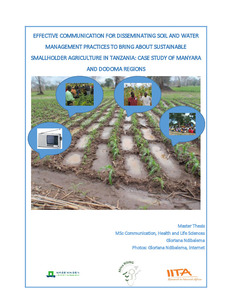| dc.contributor.author | Ndibalema, G. |
| dc.date.accessioned | 2022-11-30T09:10:19Z |
| dc.date.available | 2022-11-30T09:10:19Z |
| dc.date.issued | 2019-05 |
| dc.identifier.citation | Ndibalema, G. (2019). Effective communication for disseminating soil and water management practices to bring about sustainable smallholder agriculture in Tanzania: Case study of Manyara and Dodoma regions. Wageningen, Netherlands: Wageningen University and Research Centre (84 p.). |
| dc.identifier.uri | https://hdl.handle.net/20.500.12478/7941 |
| dc.description.abstract | This study investigated effective communication for disseminating soil and water management (SWM) practices for sustainable smallholder agriculture. Higher uncertainties in precipitation and land degradation are potentially the most limiting reasons for poor performance of rainfed agricultural sectors in Tanzania. Despite the increased focus on sustainable intensification of African agriculture and an increase of agricultural innovations with potential to alleviate these, adoption by smallholder farmers is slow. This includes soil and water management practices designed to minimize land degradation and increase productivity which few farmers implement. Studies note that although researchers generate good technologies, the lack of appropriate communication strategies, tools and methodologies lead to poor extension information and technologies resulting in low adoption of the innovations. Therefore, to find a solution to this problem, this study was guided by four research questions: 1) How is the communication flow between stakeholders through channels for disseminating SWM practices? 2) What are the common and preferred communication channels in disseminating SWM practices? 3) What are the motivations for using the communication channels in disseminating SWM practices? 4) How can the communication on disseminating of SWM practices be improved to support sustainable agriculture? The study was conducted in Kongwa District in Dodoma Region and Babati District, Manyara Region of Tanzania. A net-map tool, questionnaires and semi structured interviews were used to collect both qualitative and quantitative data for this study. Mass media and interpersonal communication are used in disseminating SWM practices information to farmers in Babati and Kongwa districts. But farmers preferred interpersonal channels as sources of SWM information including from extension officers, researchers, fellow farmers, village meetings and mobile phones. The preference was because these channels are not only informative compared to mass media but they are interactive and inclusive, which gives farmers the opportunity for giving feedback on the information disseminate. This influences farmers to not only to get information but also trigger their learning and adoption of the innovation. Agricultural exhibition events should be organised at village or ward levels to provide practical backstops against which the experts can deliver information and knowledge to farmers, and give opportunity to farmers to access knowledge. It will be helpful to increase the number of extension officers who will facilitate effective communication and dissemination of the information as they seem to be an important link for interpersonal between farmers and other agricultural stakeholders. |
| dc.description.sponsorship | United States Agency for International Development |
| dc.format.extent | 84 p. |
| dc.language.iso | en |
| dc.publisher | Wageningen University and Research Center |
| dc.subject | Soil Management |
| dc.subject | Water Management |
| dc.subject | Communication |
| dc.title | Effective communication for disseminating soil and water management practices to bring about sustainable smallholder agriculture in Tanzania: case study of Manyara and Dodoma regions |
| dc.type | Thesis |
| cg.contributor.affiliation | Wageningen University and Research Centre |
| cg.contributor.affiliation | International Institute of Tropical Agriculture |
| cg.coverage.region | Africa |
| cg.coverage.region | East Africa |
| cg.coverage.country | Tanzania |
| cg.identifier.bibtexciteid | NDIBALEMA:2019 |
| cg.authorship.types | CGIAR and advanced research institute |
| cg.iitasubject | Natural Resource Management |
| cg.iitasubject | Soil Fertility |
| cg.publicationplace | Wageningen, The Netherlands |
| cg.accessibilitystatus | Limited Access |
| cg.reviewstatus | Internal Review |
| cg.usagerightslicense | Copyrighted; all rights reserved |
| cg.targetaudience | Scientists |
| cg.futureupdate.required | No |

